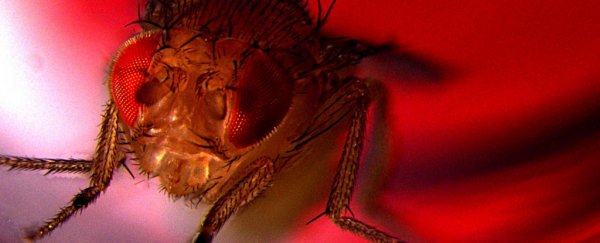A few minor tweaks of a fruit fly's genes have allowed scientists to make them ejaculate inside an actual red light district - and this research was done to better understand the brain's reward pathways.
Nobody said science has to be glamorous, and the study does have a serious side – compared with a frustrated control group, the orgasmic insects showed less interest in alcohol, highlighting neurological circuitry that might be involved in addiction.
It might come as no surprise to many of us, but past research has shown sex is fun even for the simplest of animals. Why else would we all go to the effort of finding a mate?
Not getting enough of it is apparently enough to drive a Drosophila to drink, inspiring researchers from Bar-Ilan University in Israel to head up a study into links between pleasure and alcoholism.
"Successful mating is naturally rewarding to male flies and increases the levels of a small peptide in the brain called neuropeptide F," says molecular biologist and senior researcher Galit Shohat-Ophir.
"Male flies that are sexually deprived have increased motivation to consume alcohol as an alternative reward."
To determine the neurology behind the process, the researchers cut to the chase and did away with the whole mating business, focusing solely on the fly's release of seminal fluid.
"We wanted to know which part of the mating process entails the rewarding value for flies," says Shohat-Ophir.
Flies were engineered to ejaculate under red light by having a type of nerve in the abdomen coupled to a type of light-detecting receptor.
These experimental flies were placed into a container where only half of the zone was appropriately illuminated. Their movements were then compared with those of a control group made up of non-engineered flies.
Giving the container a subtle shake every now and then forced the flies to relocate, and the researchers timed how long each group spent in the two halves of the container.
Sure enough, flies forced to release semen beneath the lamp's crimson radiance returned to the light side of the box far more often than those who had to climax the old fashioned way.
Just to be sure the flies were really enjoying themselves, the team repeated the experiment, only this time they added a smell to the box.
When the flies were provided with a selection of perfumes, they showed a clear preference for the fragrance that took them back to those heady minutes spent in the red light zone.
In addition, when offered food laced with ethanol, the satisfied flies turned it down in favour of a plain old sugar meal, unlike the control Drosophila who happily lapped up the tainted brew.
On closer inspection, the nervous systems of the engineered subjects also showed elevated levels of that pleasure chemical neuropeptide F, providing fairly solid evidence that ejaculation itself was all that was needed for the fly's rewarding sensation.
Taken as a whole the experiment's results imply that when rewarding changes in the nervous system aren't sufficient, an animal might turn to alternatives to meet the shortfall.
"One can speculate that vulnerability to addiction is related to the size of the 'reservoir' that needs to be filled, or to different sensitivity to changes in the reward levels," says Shohat-Ophir.
For decades researchers have been looking for links between rewarding social behaviours and preferences for chemical stimulation.
In the 1970s, Canadian psychologist Bruce K. Alexander studied addiction in rodents by building a rat paradise and comparing its residents' taste for opiates with those in boring old steel cages.
While repeated studies on 'Rat Park' have found conflicting results, it does seem clear that addiction involves those very same neurological pathways that evolved to encourage us to perpetuate the species.
"The principles by which the brain processes reward are extremely conserved in all animals; this is a really basic every day machinery that helps animals survive," says Shohat-Ophir
By understanding what makes us happy, we might have better ways to treat other addictive behaviours.
This research was published in Current Biology.
